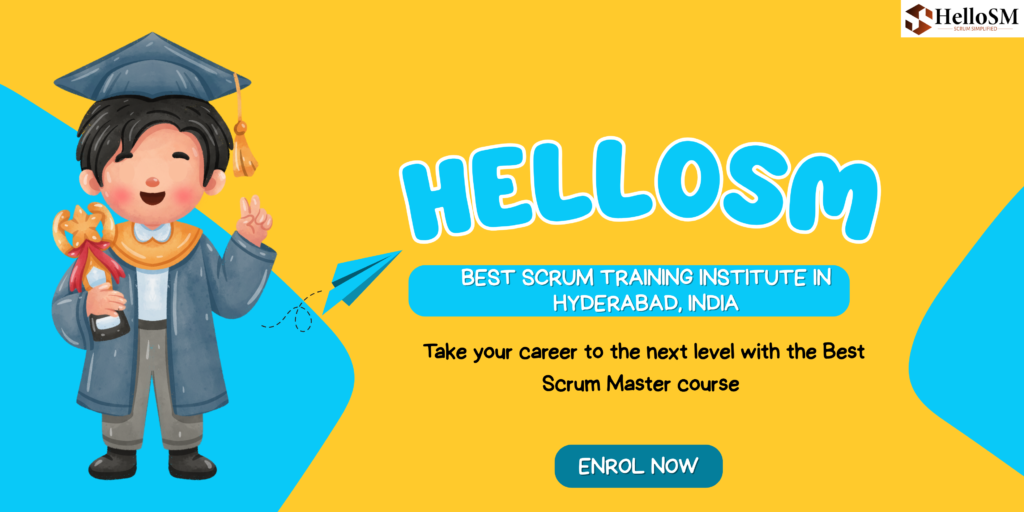Writing user stories is one of the simplest yet most powerful tools in Agile software development. A well-crafted user story improves collaboration, drives clarity, and helps development teams build the right features. But with so many approaches and templates available, how do you choose the right one?
At HelloSM, the best Scrum training institute in Hyderabad, we teach Agile professionals how to write user stories that actually work clearly, actionable, and aligned with user needs. This Agile user story template has become a go-to approach for thousands of Agile teams worldwide—and for good reason.

Power of the Three-Part User Story Template
The classic user story template follows this format:
As a [user role], I [want to achieve something], so that [value or reason].
This structure addresses three core questions:
- Who is the user?
- What do they want?
- Why do they want it?
These three simple elements: role, goal, and reason make user stories highly relatable, easy to write, and even easier for stakeholders to understand. It mirrors how we tell real-life stories and aligns naturally with the way our brains process information.
Whether you’re working on a product interface, backend logic, or API integration, this structure helps teams focus on value delivery rather than just technical execution.
Real-Life User Story Examples
Let’s look at a few user story examples for software development:
- As a registered user, I want to reset my password so that I can regain access if I forget it.
- As a content editor, I want to preview my articles before publishing so that I can ensure proper formatting.
- As a project manager, I want a dashboard with progress tracking so that I can monitor team performance in real time.
These examples show how this format can be used across various roles and goals within a product.
The Sequence Mirrors How We Think
Putting “who” first ensures that the story centers around the user, not the technology. This helps developers and designers empathize with the user before jumping into the solution.
First-Person Perspective Builds Connection
By using “I”, stories feel more personal and relatable. This encourages teams to think from the user’s point of view.
It’s Simple for Stakeholders to Contribute
This template doesn’t require a deep understanding of software development. Stakeholders and business users can easily contribute to backlog grooming by just filling in the blanks.
Promotes Prioritization
Including the “so that” clause helps Product Owners understand business value—essential when prioritizing stories during Sprint Planning or story mapping.
Should the “So That” Be Mandatory?
Not always. While the “so that” clause offers value, there are cases where it may feel redundant. For example:
- As a member, I am required to log in.
- Even if we added “so that my account is secure”, the intent is already clear.
However, our research shows that in 97% of cases, this clause adds clarity and supports better development decisions.
When Not to Use the Template?
There are times when user stories don’t fit neatly into the template. For example:
- Background processes with no direct user interaction
- Internal system alerts
- Quick fixes or technical debt
In such cases, alternative formats or free-form backlog items may be more appropriate. And that’s okay being Agile means being flexible, not blindly following rules.
User Story Templates You Can Use
- [User Story Template Word Doc]: Great for formal documentation or presentations.
- [User Story Template Excel]: Ideal for large backlogs and collaborative refinement.
- [Agile User Story Template PDFs]: Perfect for printing or sharing with stakeholders.
If you’re searching for structured resources and tools, visit HelloSM, your gateway to high-quality Scrum education. If you’re looking to sharpen your Agile skills, understand user stories in Agile with examples, or access templates for Word, Excel, and Jira, HelloSM is the top Scrum training institute in India. Our expert-led courses cover everything from Scrum fundamentals to advanced Product Owner and Scrum Master techniques.
Whether you’re in Hyderabad or attending online, our programs are designed to elevate your Agile mindset and hands-on skills. Visit HelloSM to learn more and explore our upcoming training sessions.
Frequently Asked Questions
What are the elements of a user story in Agile?
A user story typically contains three elements: Who (the user), What (the need or action), and Why (the value or purpose). These align with the format: As a [user], I [want/need] so that [reason].
Are there downloadable user story templates?
Yes. You can find user story templates in Word and Excel formats online or through training resources provided by institutes like HelloSM.
Can you give user story examples for software development?
Certainly. Example: As a mobile user, I want to receive push notifications so that I stay updated with real-time offers.
What is the benefit of using “I want” in the story?
It personalizes the requirement and puts the focus on the user’s goals. This improves empathy and clarity across the team.
Do I always have to use the ‘so that’ clause?
No, but it’s highly recommended in most cases as it adds context and helps with prioritization and implementation clarity.
Where can I learn how to write effective user stories?
You can learn through certified Scrum training programs. HelloSM, the best Scrum training institute in Hyderabad, offers comprehensive workshops and certifications.
Why should I choose HelloSM for Scrum training?
HelloSM is recognized as a top Scrum training institute in India with expert trainers, hands-on practice, real-world case studies, and complete support.
